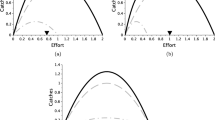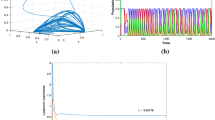Abstract
Though the maximum sustainable yield (MSY) approach has been legally adopted for the management of world fisheries, it does not provide any guarantee against from species extinction in multispecies communities. In the present article, we describe the appropriateness of the MSY policy in a Holling–Tanner prey–predator system with different types of functional responses. It is observed that for both type I and type II functional responses, harvesting of either prey or predator species at the MSY level is a sustainable fishing policy. In the case of combined harvesting, both the species coexist at the maximum sustainable total yield (MSTY) level if the biotic potential of the prey species is greater than a threshold value. Further, increase of the biotic potential beyond the threshold value affects the persistence of the system.











Similar content being viewed by others
References
Legovic, T., Klanjscek, J., Gecek, S.: Maximum sustainable yield and species extinction in ecosystems. Ecol. Model. 221, 1569–1574 (2010)
Walters, C.J., Christensen, V., Martell, S.J., Kitchell, J.F.: Possible ecosystem impacts of applying MSY policies from single-species assessment. ICES J. Marine Sci. 62, 558–568 (2005)
Botsford, L.W., Castilla, J.C., Peterson, C.H.: The management of fisheries and marine ecosystems. Science 277, 509–515 (1997)
Schaefer, M.B.: Some aspects of the dynamics of populations important to the management of commercial marine fisheries. Bull. Inter-Am. Trop. Tuna Comm. 1, 25–56 (1954)
Kar, T.K., Matsuda, H.: Sustainable management of a fishery with a strong Allee effect. Trend. Appl. Sci. Res. 2(4), 271–283 (2007)
Legovic, T., Gecek, S.: Impact of maximum sustainable yield on independent populations. Ecol. Model. 221, 2108–2111 (2010)
Legovic, T., Gecek, S.: Impact of maximum sustainable yield on mutualistic communities. Ecol. Model. 230, 63–72 (2012)
Matsuda, H., Katsukawa, T.: Fisheries management based on ecosystem dynamics and feedback control. Fish. Oceanogr. 11, 366–370 (2002)
Matsuda, H., Abrams, P.A.: Maximal yields from multispecies fisheries systems: rules for systems with multiple trophic levels. Ecol. Appl. 16, 225–237 (2006)
Katsukawa, T.: Numerical investigation of the optimal control rule for decision-making in fisheries management. Fish. Sci. 70, 123–131 (2004)
Abrams, P.A., Roth, J.D.: The effects of enrichment of three-species food chains with nonlinear functional responses. Ecology 75(4), 1118–1130 (1994)
Zhang, N., Chen, F., Su, Q., Wu, T.: Dynamic behaviors of a harvesting Leslie–Gower predator–prey model. Discret. Dyn. Nat. Soc. 2011, 1–14 (2011)
Hsu, S.B., Huang, T.W.: Global stability for a class of predator–prey systems. SIAM J. Appl. Math. 55(3), 763–783 (1995)
Ruan, S., Xiao, D.: Global analysis in a predator–prey system with nonmonotonic functional response. SIAM J. Appl. Math. 61(4), 1445–1472 (2001)
Pireddu, M., Zanolin, F.: Chaotic dynamics in the Volterra predator–prey model via linked twist maps. Opusc. Math. 28(4), 567–592 (2008)
Legovic, T.: Impact of demersal fishery and evidence of the Volterra principle to the extreme in the Adriatic Sea. Ecol. Model. 212, 68–73 (2008)
Takashina, N., Mougi, A., Iwasa, Y.: Paradox of marine protected areas: suppression of fishing may cause species loss. Popul. Ecol. 54, 475–485 (2012)
Acknowledgements
The research work of Bapan Ghosh is financed by the Council of Scientific and Industrial Research (CSIR), India (File No. 08/003(0077)/2011-EMR-I, dated 23rd March, 2011) and the research work of Dr. T.K. Kar is supported by the University Grants Commission (UGC), India (F. No. 40-239/2011(SR), dated 29th June, 2011). The authors are sincerely grateful to the anonymous referees for their valuable comments and suggestions for the improvement of the manuscript.
Author information
Authors and Affiliations
Corresponding author
Rights and permissions
About this article
Cite this article
Ghosh, B., Kar, T.K. Maximum sustainable yield and species extinction in a prey–predator system: some new results. J Biol Phys 39, 453–467 (2013). https://doi.org/10.1007/s10867-013-9303-2
Received:
Accepted:
Published:
Issue Date:
DOI: https://doi.org/10.1007/s10867-013-9303-2




